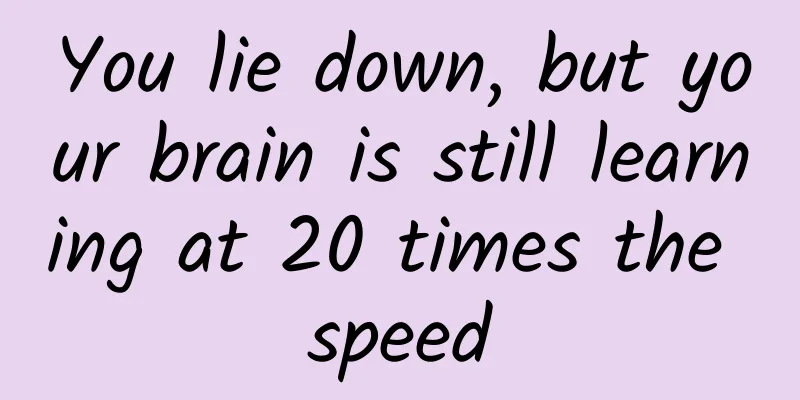You lie down, but your brain is still learning at 20 times the speed

|
Life experience tells us that it is important to combine work and rest. Appropriate relaxation can enable people to devote themselves to study and work in a better state. A new study published recently also found that during a resting state of wakefulness, brain activity can "replay" a just-learned action sequence at 20 times the speed, a process that may be important for memory consolidation. The study was published in Cell Reports on June 8. "Our study is the first to demonstrate that neural replay of recently learned skills occurs during wakefulness in humans. It is also the first to show that neural replay activity during wakefulness predicts rapid consolidation of memories, which is critical for early learning," said senior author Leonardo G. Cohen of the National Institute of Neurological Disorders and Stroke (NINDS), part of the National Institutes of Health. What does your brain do when you rest? When learning a new skill, memory consolidation and performance improve if rest periods are frequently inserted during practice time. This phenomenon is called the spacing effect and has been demonstrated in a variety of tasks. Memory consolidation during wakefulness occurs over a period of seconds to minutes and is approximately four times greater than the post-sleep memory consolidation that has been the focus of classic studies. But until now, it has been unclear how the brain combines discrete movement representations into a unified skill with a clear temporal sequence of movements during the resting state (i.e., the awake, relaxed state). One possible mechanism is neural replay, whereby during a period of rest, the neural activity patterns that represent the behavioral sequence become reactivated and compressed in time, as if a "fast-forward" of the neural activity were added. "Resting-state neural replay may facilitate skill consolidation during wakefulness by replaying prior practice offline, an issue that has not been previously investigated in humans or animal models," said Ethan R. Buch of NINDS, lead author of the study. The truth about work and rest To test this idea, the researchers used a brain imaging technique called magnetoencephalography (MEG). 30 subjects repeatedly typed "41324" on a keyboard as quickly and accurately as possible, with each experiment lasting 10 seconds and repeated 36 times, with a 10-second break between two experiments. MEG data showed that their brains underwent neural replay of the key sequence in the resting state. Neural replay lasts just 50 milliseconds, which is 20 times faster than actual movement. Neural replay occurs approximately three times more often during the rest period between exercises than during the rest period before or after training. Furthermore, neural replay was more frequent during the rest period between the last 11 trials, when subjects learned faster, compared with the first 11 trials. Furthermore, more frequent replay events during the rest period between practice sessions were associated with greater skill consolidation. The brain networks involved in neural replay include the hippocampus, sensorimotor areas, and entorhinal areas. "The deep involvement of the hippocampus and temporal lobe in procedural motor memory was surprising because this type of memory activity is generally thought to require no hippocampal involvement," Buch said. "Taken together, our data suggest that frequent, rapid neural replay during resting state strengthens hippocampal and neocortical associations activated during prior practice, a process that is associated with improved subsequent performance and consolidation of skills during wakefulness." Going forward, the researchers plan to use noninvasive brain stimulation to test whether awake replay plays a causal role in early skill learning and to determine whether rapid consolidation can also strengthen other types of memories.” Ultimately, understanding the features of lucid replay that are important for skill learning could help optimize treatment options or identify better brain stimulation strategies to improve rehabilitation outcomes after brain injuries such as stroke,” Cohen said. Source: Science Popularization China WeChat Official Account Compiled by: Qi Yiyin References: https://eurekalert.org/pub_releases/2021-06/cp-hbr060321.php The pictures in this article with the "Science Popularization China" watermark are all from the copyright gallery. The pictures are not authorized for reprinting. |
<<: How many black holes are there in the universe? The latest number: 400 billion billion!
Recommend
Workers flock to traditional Chinese medicine hospitals for massage, and doctors urgently recommend...
Review expert: Wang Linyu, deputy chief physician...
BYD launches new e-platform 3.0 Evo, first model Sea Lion 07EV is launched, priced from RMB 189,800
On May 10, BYD's new generation e-platform 3....
Xiaohongshu’s strategy for creating hot products and case analysis!
This article mainly analyzes the brand’s marketin...
Top 10 Core Data tools and open source libraries loved by developers
Core Data is a great choice for storing and query...
The new version of iMessage is an invisible browser in iOS 10
Just as public market investors are very optimist...
Are there really benefits to getting married and having children early?
Source: Youlai Healthy Life...
Is "8 glasses of water a day" true knowledge or pseudoscience? Let's clarify the matter of drinking water today!
gossip I believe everyone has heard of the phrase...
How should business owners choose the right promotion channels!
If we want to achieve better development, we must...
How does Xiaohongshu implement its operational strategy?
It started out as a social platform and later dev...
Why do so many brands do year-end reviews, and NetEase and Alipay dominate the screen?
It is the end of the year again, and brands from ...
How to efficiently create a set of advertising creative materials?
How to design a good set of materials quickly and...
Shocking! Mobile hotspots have become a new scam den, and you may lose everything if you are not careful!
In today's digital age, mobile phones have be...
No idea for event operation? Maybe you should read this article...
As an employee of the company, it is more accurat...
We once shared a common ancestor with bananas, mushrooms, and kelp! How did complex life emerge?
If you were asked to give a simple description of...
Internet mobile phones enter the knockout round, Xiaomi and others face deep distribution challenges
"What is the most powerful weapon I have? In...









